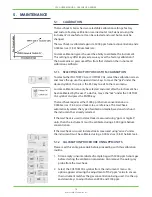
LACO USER MANUAL - GASCHECK G SERIES
15
© 2018 FLUIDX Equipment, Inc.
Should a probe become blocked, use dry, clean, compressed air to blow
out the blockage from the instrument end of the probe.
WARNING
Ensure safety guidelines are adhered to when using
compressed air.
4.4
DETECTING LEAKS
Hold the GasCheck in one hand and draw the instrument probe along
the area to be checked at approximately 25 mm per second. When a
leak is detected, retrace the route of the probe at a slower rate until the
leak is located. Once located, hold the instrument over the leak until the
measurement stabilizes. The reading can be logged by pressing the
ENTER key.
Some readings may be larger than the instrument can detect and the
measurement units will be replaced by “99999” on the display. In this case,
use the UP or DOWN key to adjust the instrument sensitivity.
Figure 3: Detecting Leaks
When detecting very small leaks, probe movement at a rate of 10mm per
second may be required.
The outer gray probe cover can be removed to allow better access to
restricted areas. If the outer probe is removed, please note the following:
• Avoid bending the inner probe. A bent probe will affect accuracy.
• To prevent probe blockage, avoid placing the probe in liquid or dirt.
• Care should be taken to ensure the brass sensor housing component
remains at a constant temperature. Avoid touching the brass sensor
block with fingers.
• The GasCheck can detect changes in humidity and carbon dioxide.
Therefore, avoid breathing on the probe.
• The thin white tube that covers the inner probe should not be removed.
This tube ensures a 1mm gap is maintained between the probe and the
surface being tested.




































